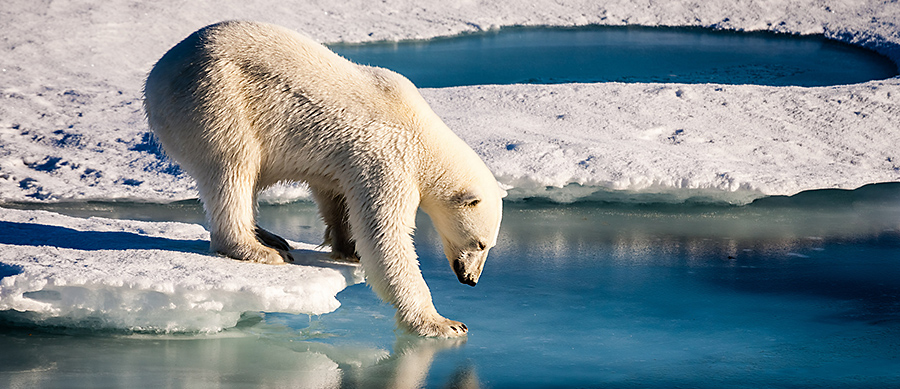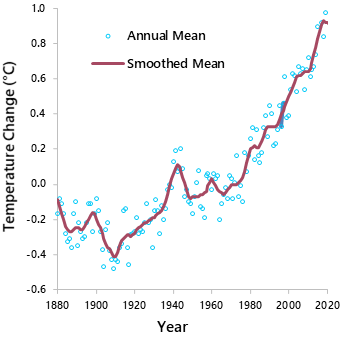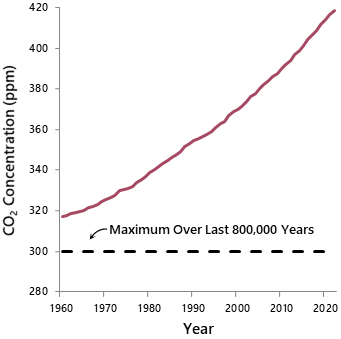Climate Change

Climate change is expected to cause widespread changes in the distribution of species and ecosystems across Canada. This presents new threats to biodiversity and it also forces us to reconsider the aims of conservation. What does it mean to maintain biodiversity in a world of constant change?
We will begin this chapter with a review of the climatic and ecological changes expected to occur in the coming decades. An important theme here is discerning the difference between change and threat. Next, we will consider the changes to conservation objectives and planning methods needed to accommodate climate change. Finally, we will discuss required adjustments to conservation practices. For the most part, adaptation entails using existing tools in new ways and for new purposes.
Canada’s Changing Climate
Global temperatures have been rising over the past century, especially since 1980 (Fig. 9.1). This increase has been attributed to a greenhouse effect arising from the anthropogenic release of CO2 and other greenhouse gases (Cook et al. 2016). The current level of CO2 is well above the maximum level recorded over the preceding 800,000 years and is steadily increasing (Fig. 9.2; Lüthi 2008).
 |
 |
| Fig. 9.1. The change in global surface temperature from 1880–2022, relative to the 1951–1980 reference period. Source: NASA 2023. | Fig. 9.2. Global CO2 concentration, 1960–2022. The dashed line indicates the maximum CO2 level recorded over the preceding 800,000 years. Source: Lüthi et al. 2008; NASA 2023. |
The rate of warming in Canada has been almost double the global average because greenhouse gas effects are magnified at high latitudes. Temperatures here are now 1.9°C above mid-twentieth-century norms (ECCC 2023). Regionally, the rise in temperature has been greatest in the northern territories and lowest in Atlantic Canada (ECCC 2023). Seasonally, warming has been greatest in winter and spring.
Trends in annual precipitation have been less discernible than those of annual air temperature. The general trend in Canada has been toward an increase in precipitation, but some regions, such as the southern prairies, have experienced a decline in recent decades, amid much year-to-year variability (Mwale et al. 2009). The Arctic has seen rapid declines in sea ice extent, both in summer and winter.
The amount and pace of future warming will depend in large part on how much more CO2 and other greenhouse gases are released in coming years. This hinges on human behaviour and political processes at the global scale. A global rise of at least 2°C (relative to the late twentieth century) seems unavoidable, given the amount of CO2 that has already been released (Clark et al. 2016). Worst-case scenarios suggest that more than 6°C of warming is possible if emissions remain unchecked. To put this into perspective, the rise in global mean temperature between the last glacial maximum, 21,000 years ago, and the beginning of the twentieth century was approximately 5°C (Clark et al. 2016).
Figure 9.3 illustrates how temperature patterns are expected to change across Canada under an intermediate level of emissions. Under this scenario, Canada’s mean annual temperature is predicted to rise by more than 4°C by the end of this century. Warming will be greatest in winter, and in this season, the largest increases in temperature are projected for northern Canada (Warren and Lemmen 2014). The melting of permafrost, which is already underway, will accelerate. In summer, the largest increases in temperature are projected for southern Canada and the central interior. Warmer temperatures will lead to a longer snow-free period in all areas, and a nearly ice-free summer is considered a strong possibility for the Arctic Ocean by 2050.
 |
|
 |
|
| Fig. 9.3. The mean annual temperature in Canada. Top: 1961–1990 reference period. Bottom: projected temperature for the 2080s under the second-lowest emission scenario (RCP 4.5; ensemble mean). Source: ClimateNA interpolation, available at https://adaptwest.databasin.org/pages/adaptwest-climatena. | |
Warmer temperatures increase the rate of evaporation from water bodies and soil and increase transpiration from plants. With more moisture in the air, precipitation will increase, though it will not be distributed evenly. Some areas, especially the southern prairies, are likely to experience a decline in precipitation in summer and fall rather than an increase (Warren and Lemmen 2014; Wang et al. 2016a). In these areas, the combination of lower summer rainfall and increased evapotranspiration from higher temperatures is expected to cause soil moisture levels to decrease during the growing season. In other areas, increased evapotranspiration and increased precipitation are likely to balance each other out, and soil moisture should remain generally stable or even increase (Price et al. 2013).
Warmer temperatures also imply an increase in the overall energy content of the atmosphere. As a result, global and regional weather patterns will become increasingly chaotic. This implies a greater frequency of extreme climatic events, including droughts, floods, and heat waves, affecting all parts of the country (Warren and Lemmen 2014).
Episodes of extremely hot and dry weather are particularly important because these conditions increase the risk of large forest fires (Flannigan et al. 2016). The lengthening of the snow-free period and constraints on fire-fighting capacity will also contribute to increased rates of burning (Wotton et al. 2017). Fire models project that the western boreal forest will be most affected. The average area burned in this region could triple by the end of the century (Balshi et al. 2009). Eastern Canada will also experience increased fire risk, though not as extreme as in the West (Wang et al. 2015).
Warming, particularly in winter, is also expected to increase the frequency and severity of insect outbreaks (Volney and Fleming 2000). The recent spread of the mountain pine beetle east of the Rocky Mountains, where cold winters had previously kept them in check, indicates that this is already becoming a reality (Cullingham et al. 2011).

